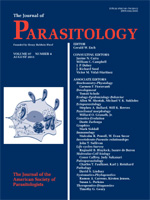Members of the Anisakidae are known to infect over 200 pelagic fish species and have been frequently used as biological tags to identify fish populations. Despite information on the global distribution of Anisakis species, there is little information on the genetic diversity and population structure of this genus, which could be useful in assessing the stock structure of their fish hosts. From 2005 through 2008, 148 larval anisakids were recovered from Pacific sardine (Sardinops sagax) in the California Current upwelling zone and were genetically sequenced. Sardines were captured off Vancouver Island, British Columbia in the north to San Diego, California in the south. Three species, Anisakis pegreffii, Anisakis simplex ‘C’, and Anisakis simplex s.s., were identified with the use of sequences from the internal transcribed spacers (ITS1 and ITS2) and the 5.8s subunit of the nuclear ribosomal DNA. The degree of nematode population structure was assessed with the use of the cytochrome c oxidase 2 (cox2) mitochondrial DNA gene. All 3 Anisakis species were distributed throughout the study region from 32°N to 50°N latitude. There was no association between sardine length and either nematode infection intensity or Anisakis species recovered. Larval Anisakis species and mitochondrial haplotype distributions from both parsimony networks and analyses of molecular variance revealed a panmictic distribution of these parasites, which infect sardines throughout the California Current ecosystem. Panmictic distribution of the larval Anisakis spp. populations may be a result of the presumed migratory pathways of the intermediate host (the Pacific sardine), moving into the northern portion of the California Current in summer and returning to the southern portion to overwinter and spawn in spring. However, the wider geographic range of paratenic (large piscine predators), and final hosts (cetaceans) can also explain the observed distribution pattern. As a result, the recovery of 3 Anisakis species and a panmictic distribution of their haplotypes could not be used to confirm or deny the presence of population subdivision of Pacific sardines in the California Current system.
How to translate text using browser tools
1 August 2011
Population Structure of Three Species of Anisakis Nematodes Recovered From Pacific Sardines (Sardinops sagax) Distributed Throughout the California Current System
Rebecca E. Baldwin,
Mary Beth Rew,
Mattias L. Johansson,
Michael A. Banks,
Kym C. Jacobson
ACCESS THE FULL ARTICLE

Journal of Parasitology
Vol. 97 • No. 4
August 2011
Vol. 97 • No. 4
August 2011




